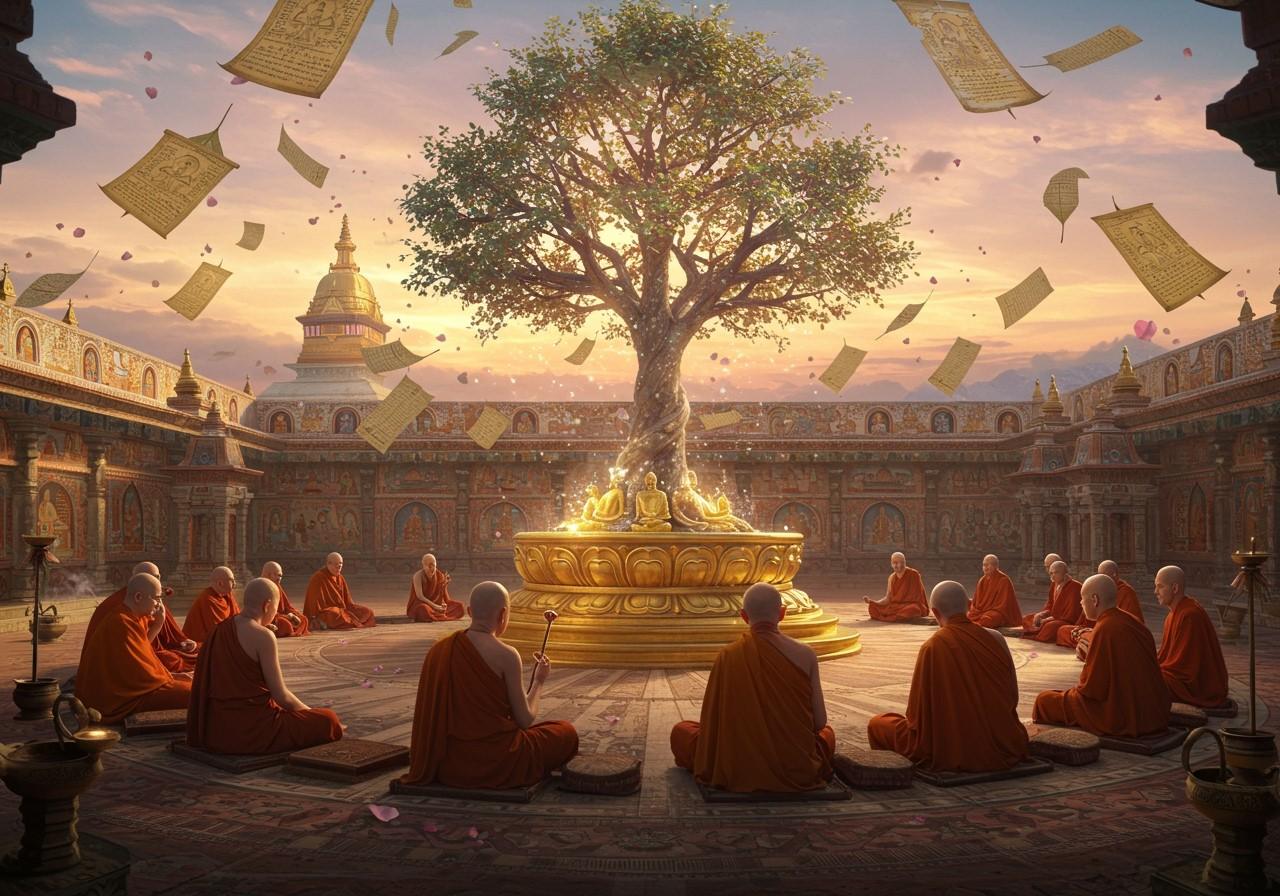
The Buddhist Councils represent pivotal moments in the history of Buddhism and Indian culture. These assemblies of Buddhist monks and scholars aimed to discuss, interpret, and preserve the teachings of the Buddha. Spanning centuries, these councils profoundly impacted the development and propagation of Buddhism. This article delves into the history, significance, and influence of these councils, offering insights for those who cherish India’s rich cultural and spiritual heritage.
The First Buddhist Council (483 BCE): Establishing the Foundation
Held shortly after the Buddha’s passing in 483 BCE, the First Council convened in Rājagaha (present-day Rajgir) under the patronage of King Ajatasatru. Led by the venerable Maha Kassapa, its primary objective was to preserve the Buddha’s teachings, known as the Dharma, and the monastic discipline, or Vinaya. Ananda, the Buddha’s attendant, recited the Suttas (discourses), while Upali recited the Vinaya. This council established a crucial precedent for future gatherings and ensured the consistent preservation of the Buddha’s teachings.
- Aim: To codify the Buddha’s teachings and establish a unified monastic code. This ensured the integrity of the Dharma and Vinaya for future generations.
- Key Figures: Maha Kassapa, Ananda (who recited the Suttas), and Upali (who recited the Vinaya). Their contributions were essential to establishing the canonical texts.
- Outcome: The compilation of the Sutta Pitaka and Vinaya Pitaka, forming the core of the Pali Canon. This standardization was crucial for maintaining the consistency of the teachings.
- Impact: Standardized the core teachings and monastic practices, laying the groundwork for the future development of Buddhist schools.
The Second Buddhist Council (383 BCE): Addressing Emerging Disputes
Approximately a century later, around 383 BCE, the Second Buddhist Council convened in Vesālī (present-day Vaishali) under the patronage of King Kalasoka. This council addressed emerging disagreements among the sangha concerning monastic rules and practices. The discussions centered around ten points of contention regarding Vinaya interpretations.
- Key Issues: Ten points of monastic discipline were disputed, revealing differing interpretations of the Vinaya. These disagreements threatened the unity of the sangha.
- Outcome: The council resulted in the first major schism within the Buddhist community, dividing the sangha into the Sthavira (Elders) and the Mahasanghika (Greater Community) schools. This division marked a significant turning point in Buddhist history.
- Impact: Highlighted the challenges of interpreting and applying the Buddha’s teachings in evolving contexts. The schism also led to the development of diverse Buddhist schools of thought.
The Third Buddhist Council (250 BCE): Purification and Expansion Under Ashoka
The Third Buddhist Council took place around 250 BCE in Pātaliputta (present-day Patna) under the influential patronage of Emperor Ashoka. This council focused on purifying the Buddhist sangha by addressing heretical views and consolidating the Dharma. The eminent monk Moggaliputta Tissa played a crucial role in guiding the proceedings.
- Key Figure: Moggaliputta Tissa presided over the council and played a key role in refuting heretical doctrines and establishing the Abhidhamma Pitaka.
- Outcome: The Abhidhamma Pitaka, a collection of philosophical treatises, was added to the Pali Canon. This addition further systematized Buddhist doctrine.
- Role of Ashoka: Emperor Ashoka’s patronage was instrumental in the council’s success and the subsequent spread of Buddhism, particularly Theravada Buddhism, to Sri Lanka and beyond. His support legitimized the council’s decisions and facilitated missionary activities.
- Impact: Strengthened the Theravada school and facilitated the widespread dissemination of Buddhism across Asia, marking a significant milestone in its global reach.
The Fourth Buddhist Council (1st Century CE): The Emergence of Mahayana
The Fourth Buddhist Council, held in the 1st century CE in Kashmir under the patronage of King Kanishka, marks a significant shift in Buddhist thought. This council focused on the Sarvastivada school and saw the compilation of extensive commentaries on the Abhidharma.
- Key Figures: Vasumitra and Asvagosha played prominent roles in shaping the philosophical discussions and textual interpretations during the council.
- Outcome: The compilation of the Mahavibhasa, a comprehensive commentary on the Abhidharma, further developed Sarvastivada doctrines.
- Role of King Kanishka: Kanishka’s support for the council provided legitimacy and resources, contributing to the flourishing of Buddhist scholarship and the spread of Buddhist ideas along the Silk Road.
- Impact: This council is often associated with the development and formalization of Mahayana Buddhism. The Mahayana school, with its emphasis on the Bodhisattva ideal and universal compassion, gained prominence and spread throughout Central Asia and East Asia.
Significance and Impact of the Buddhist Councils
The Buddhist Councils played a crucial role in shaping Buddhism as it is practiced today. They ensured the accurate transmission of the Buddha’s teachings, addressed doctrinal disputes, and maintained monastic discipline. These councils also facilitated the spread of Buddhism throughout Asia and beyond.
Royal patronage, provided by kings like Ajatasatru, Kalasoka, Ashoka, and Kanishka, legitimized the councils and facilitated the systematization of Buddhist texts. The diverse interpretations of the Dharma that emerged during these councils significantly influenced Indian society and other Asian cultures.
Poojn.in: Connecting You with Buddhist Heritage
Poojn.in, India’s leading spiritual and cultural goods store, offers a wide selection of items to support your Buddhist practice. Explore our collection of mala beads, statues, incense, and other items to enhance your connection to the Dharma.
Conclusion: A Legacy of Preservation and Guidance
The Buddhist Councils in India stand as testaments to the enduring power of preserving spiritual teachings. They ensured the survival and flourishing of the Buddha’s message, guiding millions across generations. Each council played a unique role, from codifying the teachings to resolving disputes and expanding the Dharma’s reach. The dedication and scholarship demonstrated by these councils continue to inspire practitioners and scholars today.


